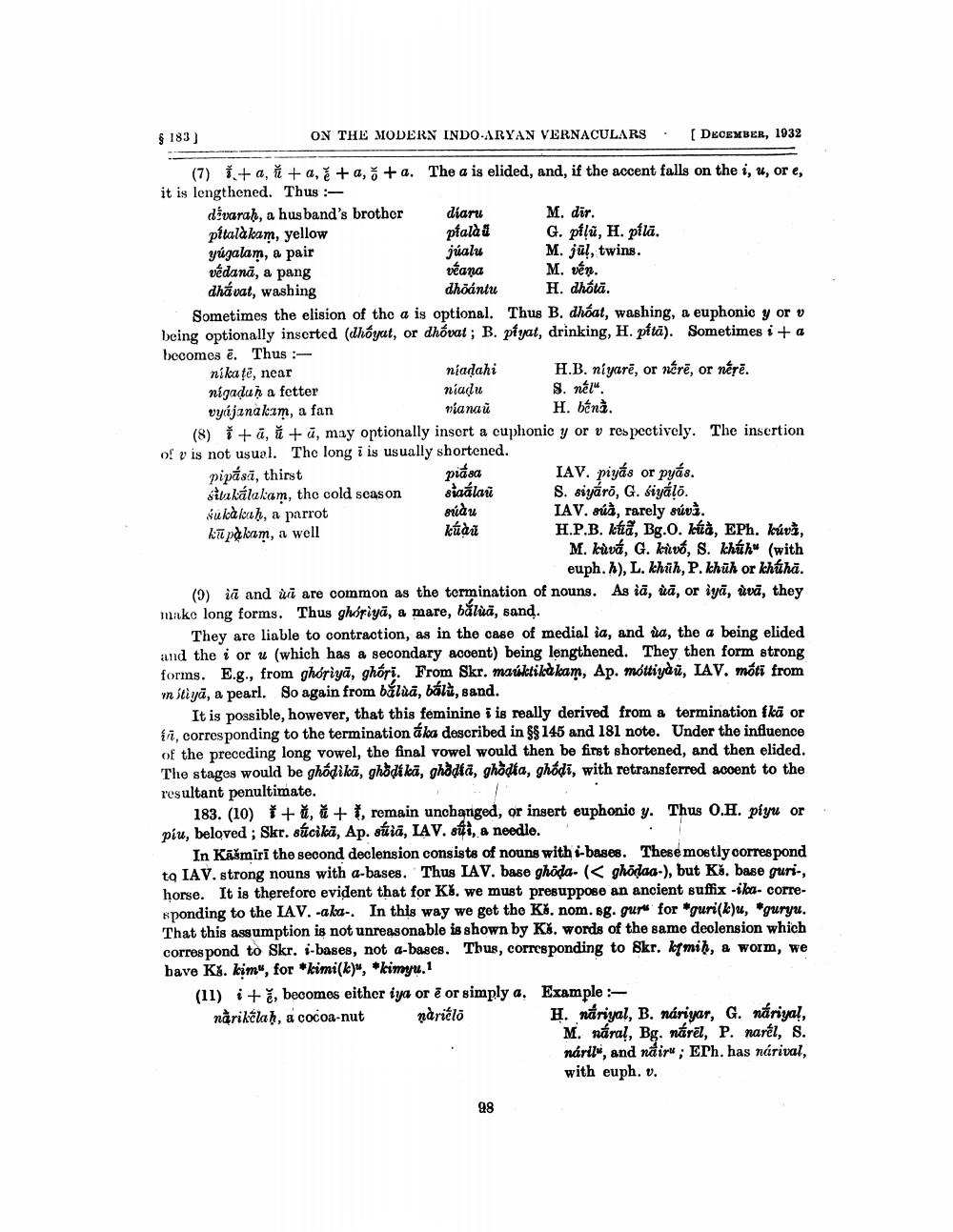________________
§ 183]
ON THE MODERN INDO-ARYAN VERNACULARS
[ DECEMBER, 1932
a,ě +a,+a. The a is elided, and, if the accent falls on the i, u, or e,
(7) + a,
it is lengthened. Thus :
divaraḥ, a husband's brother palakam, yellow
yúgalam, a pair
vedana, a pang divat, washing
nikate, near
nigaḍuḥ a fetter
vyijanakam, a fan
diaru
palà
júalu
véana
dhoántu
Sometimes the elision of the a is optional. Thus B. dhóat, washing, a euphonic y or v being optionally inserted (dhoyat, or dhovat; B. piyat, drinking, H. pita). Sometimes i+a becomes e. Thus :
pipása, thirst
sitakalakam, the cold season sukakaḥ, a parrot
ku pakam, a well
níadahi niaḍu
vianau
+ā, ǎ+ā, may optionally insert a cuphonic y or v respectively. The insertion of v is not usual. The long i is usually shortened.
(8)
piása siaálau
M. dir.
G. pilu, H. pilā.
M. jul, twins.
M. vén.
H. dhótä.
súàu
kúàu
H.B. niyare, or nére, or nerē. S. nél".
H. bénà.
IAV. piyás or pyás.
8. ár, G.
fő. IAV. súà, rarely súvà.
H.P.B. kúa, Bg.O. kúà, EPh. kúvà,
M. kùvá, G. kuvó, S. khuh" (with euph. h), L. khuh, P. khuh or khuha.
(9) in and ùu are common as the termination of nouns. As ia, ùa, or iya, uvā, they make long forms. Thus ghoriya, a mare, bálùa, sand.
They are liable to contraction, as in the case of medial ia, and ùa, the a being elided and the i or u (which has a secondary accent) being lengthened. They then form strong forms. E.g., from ghoriya, ghori. From Skr. maúktikakam, Ap. móttiyàu, IAV. móti from mitiya, a pearl. So again from balùa, bálù, sand.
It is possible, however, that this feminine i is really derived from a termination ikā or i, corresponding to the termination áka described in §§ 145 and 181 note. Under the influence of the preceding long vowel, the final vowel would then be first shortened, and then elided. The stages would be ghodika, ghodika, ghồḍtā, ghodia, ghodi, with retransferred accent to the resultant penultimate.
98
183. (10) +, +, remain unchanged, or insert euphonic y. Thus O.H. piyu or piu, beloved; Skr. sucikā, Ap. súiä, LAV. sui, a needle.
In Kašmiri the second declension consists of nouns with i-bases. These mostly correspond to IAV. strong nouns with a-bases. Thus IAV. base ghoda. (< ghodaa-), but Kš. base guri-, horse. It is therefore evident that for Kš. we must presuppose an ancient suffix -ika- corresponding to the IAV. -aka-. In this way we get the Ks. nom. sg. gur" for "guri(k)u, "guryu. That this assumption is not unreasonable is shown by Kš. words of the same declension which correspond to Skr. i-bases, not a-bases. Thus, corresponding to Skr. ktmih, a worm, we have Kš. kim", for *kimi(k)", *kimyu.1
(11), becomes either iya or é or simply a. Example:narikelaḥ, a cocoa-nut
nàriélo
H. nariyal, B. náriyar, G. náriya!, M. náral, Bg. nárēl, P. narel, S. náril", and nairu; EPh. has nárival, with euph. v.




